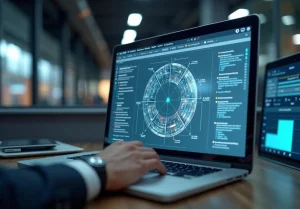Imagine you’ve discovered the secret to time travel, but the only person you can share it with thinks a DeLorean is just a car. Similarly, as a data scientist, presenting complex insights to non-technical stakeholders can feel like explaining quantum physics to high school students. They’re smart, they’re keen, but the language barrier is real.
This blog post will hand you the universal translator for data communication. By the end, you’ll not only bridge the gap but also ensure your insights are actionable, impactful, and, most importantly, understood.
Quick Takeaways:
- Employ analogies and storytelling to make complex data insights relatable and memorable to non-technical stakeholders.
- Leverage simple, annotated visuals to guide stakeholders through your data’s story, ensuring clarity and engagement.
- Practice empathy by tailoring communications to the audience’s perspective, fostering understanding and motivating action.
Why Do Non-Technical Stakeholders Often Misunderstand Data Insights?
At the heart of any data scientist’s role is the challenge of bridging the gap between intricate data insights and the practical understanding of non-technical stakeholders. But why does this chasm exist? For starters, jargon plays a big role. Just like any specialized field, data science comes with its own lexicon that, to the uninitiated, might as well be a foreign language. Terms like regression analysis, p-values, or neural networks can quickly alienate your audience.
Lack of context is another major hurdle. For data scientists, the significance of a particular dataset or finding is almost second nature. However, for those not steeped in the data daily, these insights can seem abstract or unrelated to the broader business objectives.
Finally, the abstract nature of data itself can be a stumbling block. Numbers and patterns are not inherently meaningful until they’re interpreted. Without the right framing, stakeholders can easily miss the story those numbers are telling.
Let’s be honest; the onus is on us, the data professionals, to bridge this communication gap. So, how do we go about it?
What Can You Do to Simplify Complex Data for Better Understanding?
The art of making complex data palatable is a key skill for any data scientist. Here’s how you can start mastering it:
Use Analogies and Metaphors : Think of these as the universal translators of the data world. By drawing parallels to well-understood concepts, you can quickly provide a frame of reference. For example, explaining the concept of Big Data by comparing it to finding a needle in a haystack immediately creates a visual and conceptual anchor.
Employ Storytelling : Every dataset tells a story. Your job is to narrate it in a way that highlights the ‘so what’ aspect of the data. What does this mean for the business? How can it inform decisions? Stories are memorable and can make complex ideas stick.
Focus on Key Insights : It’s easy to get lost in the weeds with data. Instead, identify the 2-3 critical takeaways from your analysis and build your communication around those. This keeps your message clear and actionable.
Unique tip : Create a “one-minute insight” challenge for yourself. Try to explain your key finding in one minute or less using simple language. This forces you to distill the essence of your insights and avoid unnecessary jargon.
How Can Visuals Aid in Communicating Data Insights?
“A picture is worth a thousand words,” particularly in the realm of data science. Here’s how you can leverage visuals:
Choose the Right Type of Visual : Not all visuals are created equal. Use bar charts for comparisons, line charts for trends over time, and scatter plots to show relationships between variables. Each type of visual serves a specific purpose, so choose wisely.
Simplicity is Key : The goal is clarity, not complexity. Avoid overly fancy visuals that can confuse rather than elucidate. Including too many elements in one chart or using confusing color schemes can detract from the message you’re trying to convey.
Annotations and Context : Use annotations to highlight the important parts of your visual. Adding a short narrative or insights directly on the visual can guide your audience to the intended conclusion without overwhelm.
Real-world example : Suppose you’re presenting customer satisfaction data over time. Instead of merely showing a line chart with ups and downs, annotate major drops with possible reasons or actions taken, turning the chart into a story of challenges and solutions.
In sum, effectively communicating data insights to non-technical stakeholders is a critical skill for data scientists. It’s about more than just sharing numbers; it’s about translating those numbers into actionable insights that can shape business decisions. Using analogies, storytelling, focusing on key insights, and employing well-designed visuals can significantly enhance your ability to convey the importance and implications of your data analysis. Remember, your goal is to make the complex understandable and ensure that the data’s value is fully appreciated by all stakeholders.
What Role Does Empathy Play in Effective Communication?
In the intricate dance of data science, where numbers and figures pirouette across spreadsheets and visualizations, the role of empathy might seem like a wallflower. Yet, it’s the secret ingredient that transforms data from sterile statistics into compelling narratives. Understanding the stakeholder’s perspective, their knowledge level, and their specific needs is not just a nice-to-have; it’s essential. It ensures that your message isn’t just heard but resonates.
Imagine you’re at a bustling international food market. Each stall entices with its own exotic flavors, colors, and aromas. Now, think of communicating data insights to non-technical stakeholders as guiding them to the stall that not only piques their interest but also caters to their diet – without overwhelming them with all the available options. That’s empathy in action.
By tailoring your message for the audience, you ensure relevance and engagement, effectively serving the dish they didn’t even know they were craving. It’s about making your data insights the perfect bite-sized delicacies they can’t wait to savor. This involves:
- Listening Actively: Understand their current concerns, objectives, and what they know.
- Simplifying without Dumbing Down: Break down complex concepts without making them feel inadequate.
- Visualizing the Story: Use visuals that align with their knowledge and interests.
In a nutshell, when data scientists put themselves in their stakeholders’ shoes, they can craft messages that don’t just inform but inspire action.
Can You Provide Examples of Effective Data Insight Communication?
Absolutely. Let’s dive into some real-life scenarios where data scientists skillfully navigated the intricate maze of conveying complex insights to a non-technical audience.
Example 1: Reducing Hospital Readmissions
Situation: A data scientist team at a healthcare provider identified patterns indicating high readmission rates for certain conditions.
Action: They distilled the complex analysis into an easily understandable narrative, focusing on the why (root causes of readmissions) and the how (specific steps to reduce them). They used a combination of simple graphs and stories of patient journeys to bring the data to life.
Result: Hospital administrators, without a background in data science, were moved by the patient stories and understood the urgency. They implemented the suggested actions, leading to a significant reduction in readmissions.
Example 2: Boosting Retail Sales through Predictive Analysis
Situation: A team spotted trends indicating certain products were likely to see a spike in demand.
Action: Instead of bombarding the non-technical sales team with complex algorithms, the data scientists created an intuitive dashboard. Using bright, engaging visuals, they highlighted which products to stock up on and when.
Result: The sales team could easily interpret the data, resulting in timely stock adjustments and a noticeable sales increase.
The Unique Touch: Tailored Email Reports
Here’s something you might not find everywhere: One especially effective method involves sending out customized email reports to stakeholders. Rather than generic, one-size-fits-all reports, these emails highlight directly relevant insights for each department, using language and visuals tailored to their specific context.
For example, a data scientist could send a marketing team an email with visuals showing the impact of recent campaigns on customer engagement, using comparisons and trends that directly tie into their upcoming decisions. This personalized approach ensures the recipients see the value and relevance of the data insights to their work, significantly increasing the likelihood of the insights being used effectively.
Remember, the essence of effectively communicating data insights lies not just in the transfer of information but in crafting a narrative that captivates, convinces, and compels non-technical stakeholders to take informed action. By prioritizing empathy and tailoring the delivery, data scientists can transform raw data into a powerful tool for strategic decision-making.


